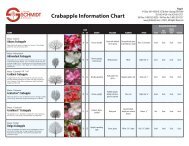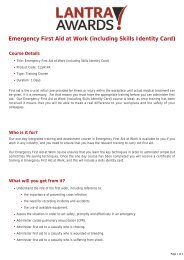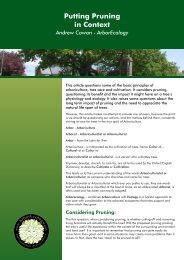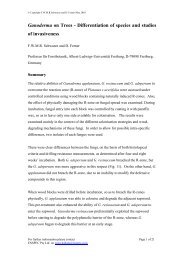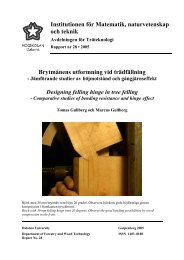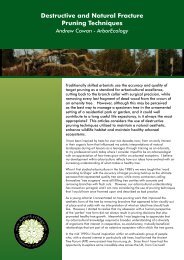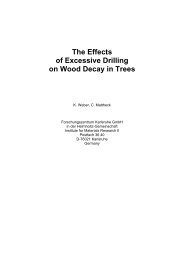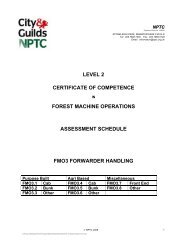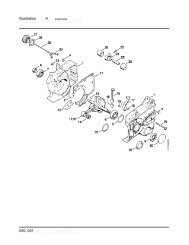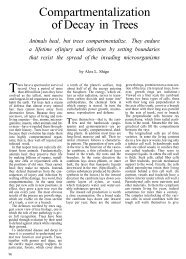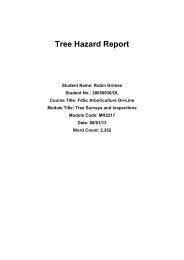(Nagel 1982, Leitl 1995). If bats are <strong>for</strong>ced to come into contact with their faeces andparasites they tend to change roost site (Stratmann 1978, Wolz 1986).Experience with large bat boxes and their suitability as hibernation sites is limited. InGermany there are some observations with the noctule (Schwarting 1994b, Dieterich 1998,Wissing 1996b) and a single one with three specimens of Leisler’s bat (Meschede & Heller2000). Some noctules have been found dead in such boxes indicating that the walls were toothin to prevent the animals from being frozen.Exposure of bat boxesThere are some indications that the percentage of boxes occupied by bats grows with thenumber of boxes available to these animals. Schmidt (1990) raised the number of bat boxesin a eastern German pine <strong>for</strong>est continuously over some years. He observed a growingnumber of bat records until an abundance of about five bat boxes per 10 hectare was reachedat sunny and semi-shaded sites. It is proposed to put up at least 10-20 bat boxes in one placeto give bats the opportunity to use the most convenient ones and change roosts from time totime (Heidecke 1989, Heise 1983a, Henze 1963, Roer 1971, Schmidt 1977). Accumulationsof about three boxes each are not necessary in general, but may support social behaviour insome species, <strong>for</strong> example the noctule (Oldenburg & Hackethal 1989, Schmidt 1977). Ifboxes are used which are suitable <strong>for</strong> both bats and birds, one should hang them up in groupsas the territoriality of a breeding bird couple will chase other birds away, so some boxes willbe kept free <strong>for</strong> bats (Haensel & Näfe 1982, Henze 1963, Roer 1971). Such groups of bat orbird boxes should be put in place at intervals of 50-100 metres (Heidecke 1989, Schwarting1994a, Dieterich & Dieterich 1997b, Schmidt 1998).Proposals <strong>for</strong> where to distribute bat boxes are very diverse. In woodlands some authorsprefer places near <strong>for</strong>est roads, paths or <strong>for</strong>est edges, others put boxes right into the <strong>for</strong>eststands. It is proved that each particular place <strong>for</strong> a bat box may influence the probability ofcolonisation by a certain bat species (Leitl 1995).In Germany, bat boxes that were actually used by bats were at heights of between 1.5 metresand 6 metres (Meschede & Heller 2000). The noctule seems to prefer boxes more than 4metres above the ground due to its style of flight departure characterized by jumpingdownwards to get some speed first (Stratmann 1978, Kronwitter 1988a, Heise & Blohm1998).In practice the height of bat boxes should be dependent on the specific place. In generalboxes should be easily available <strong>for</strong> maintenance, at least with a portable ladder. The mostconvenient and effective heights are 2.5 to 4 metres. However, along <strong>for</strong>est roads and publicfootpaths it could be safer and the disturbance risk to bats lower if boxes are fixed higher inthe trees (Meschede & Heller 2000).The direction of exposure of bat boxes is of minor relevance. For years it has beenrecommended to put them up in south- or east-facing directions and so most recent bat boxeshave such exposures. Most important to the animals is the temperature inside the boxes,which is dependent on the exposure to sunshine. Bat boxes exposed to the north get shadowfrom the tree’s trunk <strong>for</strong> most of the time. There<strong>for</strong>e in general bats prefer boxes directed tothe southwest, boxes to the south have moderate attraction and those directed to the northeastare of little interest to bats (Fuhrmann 1992). In spring and autumn bats prefer to roost in54
oxes exposed to the sun. As an example Nathusius’ pipistrelle uses boxes at sunny placesfrom April to June (Oldenburg & Hackethal 1989). During hot seasons however, bats avoidthose boxes exposed to the sun (Schmidt 1990, König & König 1995), as temperatures insideget too hot (Nagel & Nagel 1993).In Bechstein’s bat it was shown that females preferred bat boxes during the maternity period,but stayed in natural tree holes be<strong>for</strong>e and after that time. Although individual bats of acolony changed their roost every couple of days, the warmer bat boxes were always home tomore bats than cooler ones. In late summer the boxes had significant higher temperaturesinside (11.8 °C on average) compared to natural tree holes (10.3 °C on average) (Kerth andothers 2002). This behaviour is in accordance with the bats’ biology. Generally they want tocool down as fast as possible when they enter their roost, as the low body temperature at restsaves energy and is the key factor to survive periods with little <strong>for</strong>aging success. Onlyfemales that are pregnant or lactating must maintain high body temperatures all day, becauseif they cool down the young’s growth will take longer or may stop. There<strong>for</strong>e maternitycolonies are predominantly found at warm roost sites.The space in front of a bat box should not be too covered as most bats like an open area <strong>for</strong>swarming and landing at the entrance (Issel & Issel 1955, Nagel & Nagel 1988, Oldenburg &Hackethal 1989, Schmidt 1977). However, bat boxes which are hidden in dense vegetationcan be used by Bechstein’s bat, Natterer’s bat, and the brown long-eared bat in particular(Leitl 1995, Schwarting 1994a, Wissing & König 1995).Pros and cons of bat boxesThe results of investigations on the occurrence of bats in bat and bird boxes show that theseartificial roosts are accepted and used by almost all European bat species. However, expertshave not yet reached consensus on whether bat boxes really enhance populations or just causea shift in roost occupancy. Some authors interpreted their results to be based on a higherroost quality of the boxes compared to natural roosts in trees, so that the bats present in thearea changed their preferences and became more visible to observers (e.g. Schwarting 1992,Nagel & Nagel 1993). In other cases, natural roost sites in trees were very rare in an area andthe frequency of bat observations increased significantly after bat boxes were installed. Thiswas documented by Schmidt (1990, 1994a, 1994b) in pine <strong>for</strong>ests in eastern Germany and byPryswitt (in Dieterich and others 1998) in deciduous <strong>for</strong>est in northern Germany.There is also a debate about the impact of the concrete/sawdust material of bat boxes on thethumb and toenails of bats. Some observations suggested the material might be unnaturallyhard and cause friction. As an effect, toe- nails become too short and the animals may behandicapped when trying to climb a surface. However, the debate is still open and theadverse effect has not been scientifically proven yet (Vierhaus & Schröpfer 1984, vonHelversen 1989b, Fuhrmann 1989, Nagel & Nagel 1993, Weishaar 1995, Dieterich &Dieterich 1997a, Gebhard 1997).There is more discussion on bat boxes, which can be summarized in an overview of thepositive (Pros) and the negative aspects (Cons) of bat boxes:55
- Page 3: English Nature Research ReportsNumb
- Page 7 and 8: ContentsPreamble1. Legal aspects...
- Page 9 and 10: 1. Legal aspectsThere are three int
- Page 11 and 12: to the Agreement decided that the c
- Page 13 and 14: Country European Community EUROBATS
- Page 15 and 16: types in Europe where many of the e
- Page 17 and 18: • the European Commission initiat
- Page 19 and 20: Foraging areas: Central European sp
- Page 21 and 22: Other roosts: In foraging areas and
- Page 23 and 24: Brandt’s bat travels up to 250 ki
- Page 25 and 26: others 2004). Maternity colonies al
- Page 27 and 28: 1995, The Netherlands: Limpens and
- Page 29 and 30: from a maternity colony covered a t
- Page 31 and 32: hibernaculum is the Levensau Bridge
- Page 33 and 34: female (Fuhrmann and others 2002).
- Page 35 and 36: Foraging areas: In Central Europe f
- Page 37 and 38: Table 2 Importance of tree holes fo
- Page 39 and 40: sites it was found that the possibi
- Page 41 and 42: advancing age of a tree its potenti
- Page 43 and 44: floor up to the canopy and beyond c
- Page 45 and 46: Table 6 Overview of the most freque
- Page 47 and 48: 6.2 2nd step: Active search for roo
- Page 49 and 50: This first approach to a woodland b
- Page 51 and 52: number of tree-dwelling birds in pr
- Page 53: Types of boxes used by batsThere ar
- Page 57 and 58: Con: Bats use bat boxes selectively
- Page 59 and 60: 9. ReferencesABULADZE, A., BUXNIKAS
- Page 61 and 62: BEKKER, J.P. 1990. Ervaringen met v
- Page 63 and 64: BRAUN, M., & HÄUSSLER, U. 2003c. K
- Page 65 and 66: Ökologie und Verbreitung von Arten
- Page 67 and 68: (Germany). In: PRIEDE, I. G. & SWIF
- Page 69 and 70: (Nyctalus leisleri) sowie zur Besie
- Page 71 and 72: HEISE, G. 1985. Zu Vorkommen, Phän
- Page 73 and 74: JONES, G. 1990. Prey selection by t
- Page 75 and 76: (Chiroptera: Vespertilionidae). - P
- Page 77 and 78: Ökologie und Verbreitung von Arten
- Page 79 and 80: PÉREZ, J. L. & IBÁÑEZ, C. 1991.
- Page 81 and 82: ROTTMANN, R., BOYE, P. & MEINIG, H.
- Page 83 and 84: SCHORCHT, W., and others. 2002. Zur
- Page 85 and 86: STUTZ, H.-P. B. & HAFFNER, M. 1989.
- Page 87 and 88: WAGNER, M., KERTH, G. & KÖNIG, B.
- Page 89: 10. AuthorsDr. Peter Boye became fa



